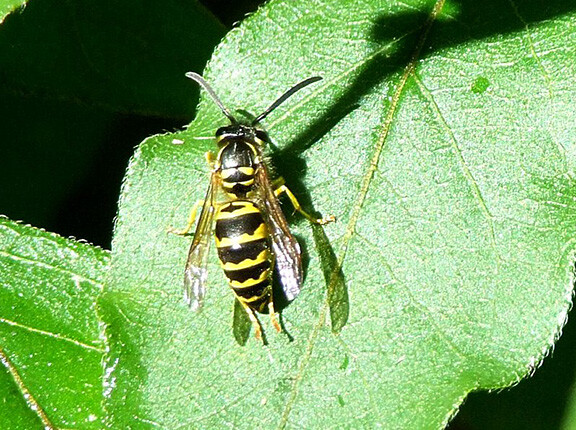Image

LEBANON, OH -- The term yellow jacket is applied to a common wasp that inhabits our area going unnoticed much of the time. But as summer slides into autumn, they become more conspicuous as they forage for food often invading our gardens, orchards, and even picnic outings.
Yellow jackets are carnivorous, primarily feeding on other insects like flies and bees. But they do have a sweet tooth.

You can count on finding them feeding on overripe fallen fruit such as apples or pears. They enjoy the nectar of some garden flowers and relish the sugar water in my hummingbird feeder! The hummingbirds recognize yellow jackets as a danger and flee to a safer place if they encounter any at the feeder.
Yellow Jackets are common uninvited guests at the picnic table. They haven’t met a hotdog or hamburger that they don’t like. Perhaps their favorite item on the menu is that open can of soda pop or cup of sweetened ice tea or lemonade.
We need to be very careful to not let a yellow jacket sting us on the mouth while we are eating outdoors. They will sting at the slightest provocation, and it is a painful experience to be avoided at all cost.
Yellow Jackets are easily recognized by alternating yellow and black bands along their inch-long abdomen. They reproduce and live in large honeycomb colonies that may be underground in a mole tunnel or chipmunk burrow. Or, they may establish their home above ground in the rafters of buildings, under siding, or in your attic!
I’ve had them swarm out of the ground and sting me multiple times on the legs when I unknowingly ran the lawn mower over an underground hive.
Years ago, I came home to a house swarming with yellow jackets inside. They had established a colony between the first and second floor levels, then chewed through the drywall ceiling in the family room and entered by the hundreds!
They stung one of our two cats on the nose, and my wife on her neck!
I exterminated the colony with an insecticide sprayed into the opening they created in the ceiling, plugged the hole, and swept up all of the escapees with the vacuum cleaner hose! I then determined that their entry point was a bottom strip of exterior aluminum siding that had a gap at its lower edge. I plugged the gap and that ended the invasion.
With all that evidence giving the yellow jacket a bad reputation, there must be something beneficial about them to justify their existence. The most I can come up with is... that to a small extent, they are flower pollinators.